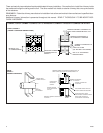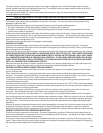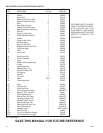
14 EC95
FIGURE 11 - CHIMNEY HEIGHT REQUIREMENTS
6. Check the entire system for obstructions that could be causing resistance to the flow of smoke and gases up the
chimney.
7. Check the size of the chimney flue liner. If the chimney flue liner’s inside dimension is smaller that 6 inches round
or 8 inches square, it will be too restrictive to the flow of smoke and gases. A chimney flue liner which has an inside
cross-sectional area of more that 85 square inches is too large, which will result in excess capacity, which means
less draft and more creosote. If the chimney flue liner is too large, it may be improved by restricting the top opening
of the flue to a 6 inch round opening, or in more extreme cases, the chimney may have to be relined with a smaller
lining and a metal prefabricated chimney may have to be replaced.
WHAT TO DO IF THE HEATER BURNS TOO RAPIDLY OR OVERHEATS
1. If the room in which the heater is located becomes uncomfortably warm on moderately cool days, it may be because
you are placing too much wood in the heater for the amount of heat required to heat your home. Although the
thermostatically controlled inlet air damper on the heater is intended to control the burning rate of the wood, a certain
amount of air must enter the heater at all times to assure the fire does not go out and the wood burns as cleanly as
possible. Thus you should adjust the amount of wood you put in the heater to the outdoor temperature. Placing
excessive wood in the heater will cause excessive creosote formation in the chimney, waste wood, and make the
room uncomfortably warm.
2. If the heater burns too rapidly or overheats, it may be because air is leaking around a loose door gasket or a fuel
feed door or ash door latching pawl and handle may need adjusting. Check thoroughly for leaks where air may be
entering the heater’s firebox.
3. If the heater burns too rapidly or overheats due to excessive draft as described earlier, you may wish to consider
purchasing a barometric damper top be installed in the heater’s chimney connector. The barometric damper should
be set to regulate a .06 draft through the heater. Check with your heater dealer.
QUICK REFERENCE TO THE MOST COMMON SOLUTIONS FOR THE MOST COMMON HEATER OPERATIONAL
PROBLEMS
1. Symptom: Fire rate does not increase with thermostat open, smoke spilling from feed door when tending fire or
backpuffing.
Check for:
a. Chimney connector pushed too far into a masonry chimney thimble restricting draft.
b. Chimney or chimney connector restricted with creosote.
c. Chimney draft reduced by air entering through:
-Unsealed chimney clean-out access.
-Loose mortar or cracked chimney wall.
-Holes in rusted chimney connector.
-Incompletely sealed chimney connector joint or thimble
d. Downdraft in too large chimney or chimney with no cover.
e. Combustion air inlet blocked with ashes.
f. Chimney too short.


















